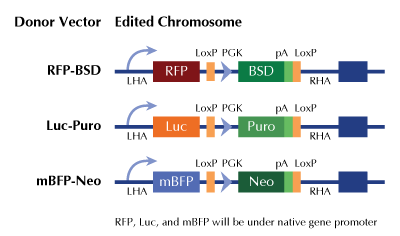NOTCH1 Human Gene Knockout Kit (CRISPR)
CAT#: KN211365BN
NOTCH1 - human gene knockout kit via CRISPR, HDR mediated
Functional Cassette: GFP-puro Luciferase-Puro RFP-BSD
HDR-mediated knockout kit validation
USD 1,657.00
4 Weeks*
Specifications
| Product Data | |
| Format | 2 gRNA vectors, 1 mBFP-Neo donor, 1 scramble control |
| Donor DNA | mBFP-Neo |
| Symbol | NOTCH1 |
| Locus ID | 4851 |
| Components |
KN211365G1, NOTCH1 gRNA vector 1 in pCas-Guide CRISPR vector KN211365G2, NOTCH1 gRNA vector 2 in pCas-Guide CRISPR vector KN211365BND, donor DNA containing left and right homologous arms and mBFP-Neo functional cassette. GE100003, scramble sequence in pCas-Guide vector |
| Disclaimer | These products are manufactured and supplied by OriGene under license from ERS. The kit is designed based on the best knowledge of CRISPR technology. The system has been functionally validated for knocking-in the cassette downstream the native promoter. The efficiency of the knock-out varies due to the nature of the biology and the complexity of the experimental process. |
| Reference Data | |
| RefSeq | NM_017617 |
| UniProt ID | P46531 |
| Synonyms | AOS5; AOVD1; hN1; TAN1 |
| Summary | This gene encodes a member of the NOTCH family of proteins. Members of this Type I transmembrane protein family share structural characteristics including an extracellular domain consisting of multiple epidermal growth factor-like (EGF) repeats, and an intracellular domain consisting of multiple different domain types. Notch signaling is an evolutionarily conserved intercellular signaling pathway that regulates interactions between physically adjacent cells through binding of Notch family receptors to their cognate ligands. The encoded preproprotein is proteolytically processed in the trans-Golgi network to generate two polypeptide chains that heterodimerize to form the mature cell-surface receptor. This receptor plays a role in the development of numerous cell and tissue types. Mutations in this gene are associated with aortic valve disease, Adams-Oliver syndrome, T-cell acute lymphoblastic leukemia, chronic lymphocytic leukemia, and head and neck squamous cell carcinoma. [provided by RefSeq, Jan 2016] |
Documents
| Product Manuals |
| FAQs |
| SDS |
Resources
Other Versions
| SKU | Description | Size | Price |
|---|---|---|---|
| KN211365 | NOTCH1 - human gene knockout kit via CRISPR, HDR mediated |
USD 1,657.00 |
|
| KN211365LP | NOTCH1 - human gene knockout kit via CRISPR, HDR mediated |
USD 1,657.00 |
|
| KN211365RB | NOTCH1 - human gene knockout kit via CRISPR, HDR mediated |
USD 1,657.00 |
|
| KN411365 | NOTCH1 - KN2.0, Human gene knockout kit via CRISPR, non-homology mediated. |
USD 1,657.00 |
|
| GA103238 | NOTCH1 CRISPRa kit - CRISPR gene activation of human notch receptor 1 |
USD 1,657.00 |
{0} Product Review(s)
Be the first one to submit a review






























































































































































































































































 Germany
Germany
 Japan
Japan
 United Kingdom
United Kingdom
 China
China
